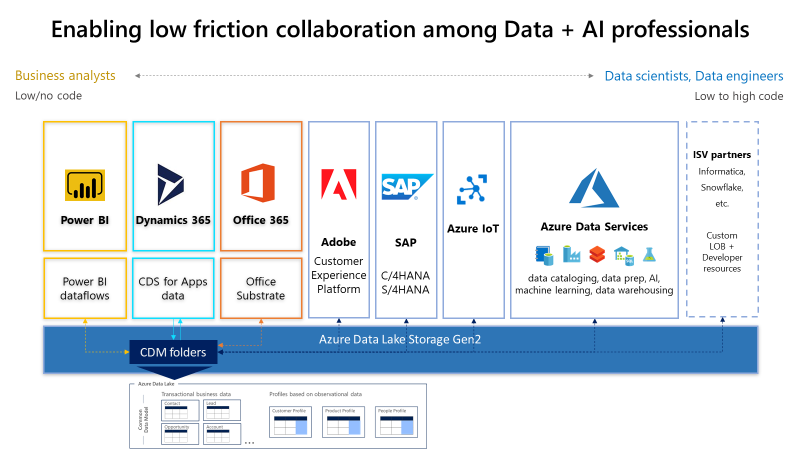Common Data Model (CDM)
Important
This content is archived and is not being updated. For the latest documentation, see Microsoft Dynamics 365 product documentation. For the latest release plans, see Dynamics 365 and Microsoft Power Platform release plans.
Note
These release notes describe functionality that may not have been released yet. To see when this functionality is planned to release, please review What’s new and planned for Common Data Model and Data Integration. Delivery timelines and projected functionality may change or may not ship (see Microsoft policy).
Today’s Common Data Model (CDM) provides modular and extensible business entities (account, lead, opportunity, and so on) as well as observational data concepts (such as Link clicks and Email opens). It unifies data in a well-known schema with semantic consistency across data silos, applications, and deployments.

The span of products, platforms, and services that implement, produce, and consume data in CDM form continues to grow, inside and outside Microsoft.
Additional capabilities and features as part of the Open Data Initiative
As part of the Open Data Initiative, “one data model” across the founding partners supports a customer-owned shared data lake for intelligence and knowledge creation scenarios with direct access to the underlying data and metadata. The founding partners (and additional ones) will land their data with well-defined semantic metadata in that data lake and pull from it. This resembles the first version of “CDM folders” in Azure Data Lake Storage (ADLS) Gen2 but requires significant evolution, with multiple Azure data services and partners (for example, Informatica) building toward it.
With the huge volume of existing customer data and applications on the existing transactional platforms (such as CDS), it is not a tractable problem to converge those onto the same “one data model.” We need to ensure we make landing the data in the lake seamless and automatic. Similarly, it must be easy to gain insights from the shared data lake and bring those insights back into the platforms. This also extends the effort to include data assets from Adobe and SAP in our AI and intelligence offerings.
Updated developer and consumer documentation
The Common Data Model continues to evolve in scope and capabilities, which increases the importance of the public documentation for both consumers and developers. The release of additional quick starts, best practices, and more to the public documentation set provides a destination where anyone interested in CDM can learn how best to leverage its power.
CDM schema documents
The CDM schema definition continues to improve based on the ecosystem's needs. For example, we’ve released a versioning scheme for the CDM schema documents. This scheme ensures that producers and consumers can report and identify the versions they support.
SDK and tooling
In order to create and leverage the data in CDM shape, we’ve released an SDK and tooling to explore, read, modify, and create content in CDM form. These tools make the initiative approachable to developers across a wide range of platforms and services. These tools open their data to the growing set of services and experiences that understand data in CDM form.
New entity definitions
CDM continues to expand with the release of new industry accelerators and concepts from core Dynamics 365 solutions. For example, the release of accelerators from the education and non-profit industries, as well as updates to the healthcare accelerator, have brought more than 100 new entities to the CDM model. Additionally, entity definitions from Dynamics 365 for Finance and Operations, Marketing, Talent, and more continue to make CDM relevant to customers and partners of all sizes.